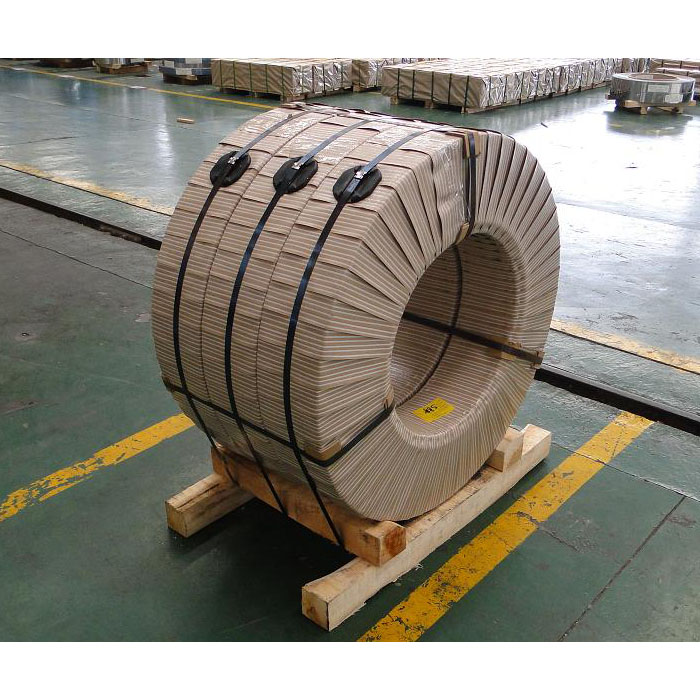ရုပ်ဂုဏ်သတ္တိများအကြား ဆက်နွယ်မှု
stainless steel ချွတ်နှင့်အပူချိန်
(၁) တိကျသော အပူပမာဏ
အပူချိန်ပြောင်းလဲမှုနှင့်အတူ၊ သီးခြားအပူခံနိုင်မှုသည်လည်း ပြောင်းလဲသွားသော်လည်း သတ္တုဖွဲ့စည်းပုံသည် အပူချိန်ပြောင်းလဲမှုအတွင်း မိုးရွာသည်နှင့်၊
stainless steel ချွတ်၊ သီးခြားအပူခံနိုင်မှု သိသိသာသာ ပြောင်းလဲသွားမယ်။
(၂) အပူစီးကူးမှု
600°C အောက်ရှိ stainless steel strip အမျိုးမျိုး၏ အပူစီးကူးမှုသည် အခြေခံအားဖြင့် 10~30W/(m·°C) အကွာအဝေးအတွင်းဖြစ်သည်။ အပူချိန်တိုးလာသည်နှင့်အမျှ အပူကူးယူနိုင်စွမ်းလည်း တိုးလာသည်။ 100°C တွင်၊ stainless steel strip ၏ thermal conductivity သည် 1Cr17, 00Cr12, 2cr25n, 0 cr18ni11ti, 0 cr18ni9, 0 cr17 Ni 12M 602, 2 cr25ni20 ဖြစ်သည် ။ 500°C တွင် အပူကူးယူမှုမှာ 1 cr13၊ 1 cr17၊ 2 cr25n၊ 0 cr17ni12m၊ 0 cr18ni9ti နှင့် 2 cr25ni20 ဖြစ်သည်။ austenitic stainless steel strip ၏ thermal conductivity သည် အခြားသော stainless steel များထက် အနည်းငယ်နိမ့်ပါသည်။ သာမန်ကာဗွန်သံမဏိများနှင့် နှိုင်းယှဉ်ပါက 100°C တွင် austenitic stainless steel ၏အပူစီးကူးမှုသည် သာမန်ကာဗွန်သံမဏိ၏ 1/4 ခန့်ဖြစ်သည်။
(၃) Linear expansion coefficient
100 - 900°C အကွာအဝေးတွင်၊ stainless steel strip အမျိုးအစားအမျိုးမျိုး၏ linear expansion coefficient အကွာအဝေးသည် အခြေခံအားဖြင့် 130*10Ëυ˹6 ~ 6°CË connected 1 ဖြစ်ပြီး ၎င်းတို့သည် တိုးလာသည်နှင့်အမျှ အပူချိန်တိုးလာသည်။ မိုးရွာသွန်းမှုကို တင်းမာစေသော stainless steel strip ၏ linear expansion coefficient ကို aging treatment temperature ဖြင့် ဆုံးဖြတ်သည်။
(၄) ခုခံနိုင်စွမ်း
0 ~ 900°C တွင်၊ stainless steel အမျိုးအစားအမျိုးမျိုး၏ ခံနိုင်ရည်မှာ အခြေခံအားဖြင့် 70*130*10ËυËυω6~6Ω·m၊ အပူချိန်တိုးလာသည်နှင့်အမျှ တိုးလာမည်ဖြစ်သည်။ အပူပေးသည့်ပစ္စည်းများအဖြစ် အသုံးပြုသည့်အခါ ခံနိုင်ရည်နည်းသောပစ္စည်းများကို အသုံးပြုသင့်သည်။
(၅) စိမ့်ဝင်နိုင်မှု
austenitic stainless steel strip ၏ သံလိုက်စိမ့်ဝင်နိုင်မှုသည် အလွန်သေးငယ်သောကြောင့် ၎င်းကို သံလိုက်မဟုတ်သော ပစ္စည်းဟုလည်း ခေါ်သည်။ 0cr20ni10၊ 0cr25ni20 စသည်ဖြင့် တည်ငြိမ်သော austenitic တည်ဆောက်ပုံများပါရှိသော သံမဏိများသည် ပြုပြင်မှုပုံသဏ္ဍာန် 80% ထက် ပိုနေသော်လည်း သံလိုက်မဟုတ်ပေ။ ထို့အပြင်၊ 1Cr17Mn6NiSN၊ 1Cr18Mn8Ni5N စီးရီး၊ မန်းဂနိစ်မြင့် austenitic stainless steel ကဲ့သို့သော ကာဗွန်မြင့်မားသော နိုက်ထရိုဂျင်၊ မန်းဂနိစ်မြင့်မားသော austenitic stainless steels များသည် ကြီးမားသောလျှော့ချရေးလုပ်ငန်းစဉ်အခြေအနေများအောက်တွင် အဆင့်ပြောင်းလဲမှုကို ကြုံတွေ့ရလိမ့်မည်၊ ထို့ကြောင့် ၎င်းတို့သည် မလုပ်ဆောင်နိုင်သေးပါ။ - သံလိုက်။ Curie အမှတ်ထက် မြင့်မားသော အပူချိန်တွင် သံလိုက်ဓာတ်များပင်လျှင် ၎င်းတို့၏ သံလိုက်ဓာတ် ဆုံးရှုံးသွားပါသည်။ သို့သော်၊ အချို့သော austenitic stainless steel strips များဖြစ်သည့် 1Cr17Ni7 နှင့် 0Cr18Ni9 တို့သည် metastable austenitic structure ရှိသည်၊ ထို့ကြောင့် martensitic transformation သည် သံလိုက်နှင့် magnetic ဖြစ်မည့် ကြီးမားသောလျှော့ချရေး သို့မဟုတ် အပူချိန်နိမ့်သည့်အတောအတွင်းတွင် ဖြစ်ပေါ်ပါသည်။ လျှပ်ကူးနိုင်စွမ်းလည်း တိုးလာသည်။
(၆) elasticity ၏ Modulus
အခန်းအပူချိန်တွင်၊ ferritic stainless steel ၏ အရှည်လိုက် ရွေ့လျားမှုပုံစံသည် 200 kN/mm2 ဖြစ်ပြီး austenitic stainless steel ၏ longitudinal modulus သည် carbon structural steel ထက် အနည်းငယ်နိမ့်သည်။ အပူချိန်တိုးလာသည်နှင့်အမျှ၊ elasticity ၏ longitudinal modulus သည် လျော့နည်းလာပြီး elasticity (တင်းမာမှု) ၏ transverse modulus သည် သိသိသာသာ လျော့နည်းသွားသည်။ elasticity ၏ longitudinal modulus သည် အလုပ် မာကျောခြင်းနှင့် တစ်သျှူးများ စုစည်းမှုအပေါ် သက်ရောက်မှုရှိပါသည်။
(၇) သိပ်သည်းဆ
မြင့်မားသော chromium ferritic stainless steel တွင် သိပ်သည်းဆနည်းပြီး နီကယ်မြင့်မားသော manganese austenitic stainless steel တွင် သိပ်သည်းဆ မြင့်မားသည်။ မြင့်မားသောအပူချိန်တွင် စာလုံးအကွာအဝေး တိုးလာခြင်းကြောင့် သိပ်သည်းဆ လျော့နည်းသွားသည်။



